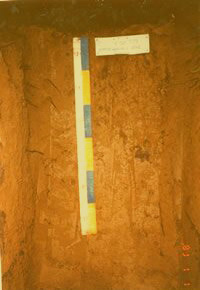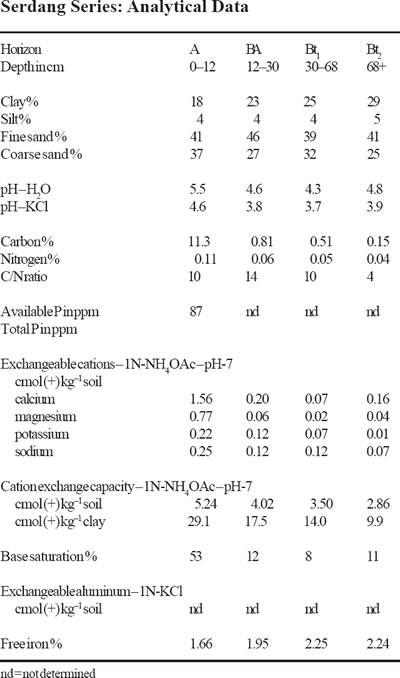Soil Profiles: Serdang
Serdang Series
The Serdang Series is a member of the family of fine loamy, siliceous, isohyperthermic, red-yellow Tipik Lutualemkuts. The Serdang Series is developed over mixed sedimentary rocks. They are developed on quartzite, sandstone or conglomerate parent material and are characterized by deep profiles having sandy loam to sandy clay loam textures. They range in colour from yellowish brown to strong brown. Structures are weak subangular blocky and consistence friable. These soils have a kandic horizon (CECclay < 16 cmol (+) kg–1 clay) which is weakly expressed but clay content increases gradually with depth. The CECclay is less than 16 cmol in all subhorizons between 25 to 100 cm depth. No significant clay decrease to 100 cm depth is allowed.
Type Location
The Serdang Series was first established during the survey of the Federal Experimental Station in Serdang by Panton (1954), near Kuala Lumpur. The above pedon was described by Vercruysse (1984) during the Semi-Detailed Soil Survey of the Gual-Periok area, Kelantan on the lower slopes of a low hill at an elevation of 20 m under rubber. Location: Topographic Sheet 3868, 6°01’35” N, 102°01’45” E (Grid Reference 3868 – 480667 m).
Range in Characteristics
Soils of the Serdang Series in spite of its widespread occurrence show fairly consistent morphological properties. The textures range from fine sandy loam, sandy loam, to fine sandy clay loams, in the surface horizon to fine sandy clay loam in the subsoil. The texture often becomes heavier (sandy clay) at depths around 100 cm. Fine sand dominates the sand fraction. Clay contents range from about 18% to about 35% within 50 cm of the surface. Only rarely do heavier textures occur. Colours are uniformly yellowish brown to brownish yellow (10YR5/6, 5/8, 6/6, 6/8). With depths the colours may be strong brown, reddish yellow (7.5YR5/6, 5/8, 6/6, 6/8, 7/6, 7/8; 5YR6/6, 6/8, 7/6, 7/8). The redder colours are more common on the steeper slopes. A red variant with red colours (10R4/6, 4/8, 5/6, 5/8; 2.5YR4/6, 4/8, 5/6, 5/8) has been mapped near Paloh in Johore but this is now included with the Laka Series. Structures are weak to moderate, medium and fine subangular to angular blocky and consistence friable even to over a metre depth. Occasionally a thin vein quartz band may be present but petroplinthite nodules are rare as a rule. These soils have thin patchy clayskins to depths over one metre. The soils are more than one metre deep. On the steeper slopes it grades into the shallower soils of the Nami and Kekura Series. On the footslopes these soils may have a few diffuse mottles at depth. As defined here soils of the Serdang Series must have a CECclay of less than 16 cmol (+) kg–1 clay in all subhorizons between 25 to 100 cm depth.
Competing Soils and Their Differences
Soils of the Serdang Series are not likely to be confused with many other soils. The Kekura and Kedah Series have similar features but the soil depth is less than 50 cm. The Nami and Keledang Series are also similar textured but soil depth ranges from between 50 to 100 cm. The Bungor Series is heavier textured, slightly stronger coloured and has relatively firmer consistence. Mottling is also invariably present in the Bungor Series. The Kemahang Series has all the features of the Serdang Series but the textures are coarse sandy clay loams. Soils of the Serdang Series can be confused with soils of the Bekenu Series (CECclay 16–24 cmol) and the Tanjong Lipat Series (CECclay > 24 cmol) mapped in Sarawak and Sabah but can be separated using the CEC values. Soils of the Serdang Series may be sometimes confused with terrace alluvial soils such as the Holyrood and Rasau Series. These soils occur level to gently undulating on river terraces. The Holyrood has coarse sandy clay loam. While the Rasau fine sandy clay loam textures. Soils of the Tukau Series in Sarawak are also developed on terraces. These soils on terraces get paler with depth and often rounded-pebbles are encountered. Soils of the Serdang Series are not likely to be confused with many other soils. The Kekura and Kedah Series have similar features but the soil depth is less than 50 cm. The Nami and Keledang Series are also similar textured but soil depth ranges from between 50 to 100 cm. The Bungor Series is heavier textured, slightly stronger coloured and has relatively firmer consistence. Mottling is also invariably present in the Bungor Series. The Kemahang Series has all the features of the Serdang Series but the textures are coarse sandy clay loams. Soils of the Serdang Series can be confused with soils of the Bekenu Series (CECclay
Setting
The Serdang Series soils occur on undulating to hilly terrain on quartzite, sandstone and conglomerate parent material. They may occupy the gentler slopes of steep ridges with the Kekura and Nami Series occurring on the steep ridge tops.
Principal Associated Soils
Soils of the Serdang Series have been often associated with soils of the Bungor, Munchong and with the Nami and Kekura Series. The Munchong Series is clayey textured, stronger structured and has an oxic horizon. The Bungor Series also has heavier textures with fine sand dominating. Consistence is also firmer and has reddish mottles at depth. The Nami and Kekura Series are shallower soils in which the parent material is encountered at depths within 100 and 50 cm respectively. As redefined here soils of the Serdang Series may be associated with soils of the Bekenu and Tanjong Lipat Series.
Drainage and Permeability
The Serdang Series is a well drained soil to over 100 cm depth. It has good permeability.
Use and Vegetation
A large variety of crops are grown on these soils. These include crops such as oil palm, rubber, fruit trees etc. Many areas with such soils are still under primary forest.
Distribution and Extent
To-date, except for the State of Perlis, these soils have been mapped in every state in Peninsular Malaysia. They have mainly been mapped in association with other soils and consequently their actual extent is not known. These as defined here may also be present in Sabah and Sarawak.
Series Established
This soil was established during the survey of the Federal Experimental Station in Serdang (Panton 1954). The source of name is Serdang Village near Kuala Lumpur.
Remarks on Classification
Soils of the Serdang Series are classified according to the Malaysian Soil Taxonomy – Second Approximation (Paramananthan 1998) as a member of the fine loamy, siliceous, isohyperthermic, red-yellow family of Tipik Lutualemkuts. They are classified as soils having a deep kandic horizon with between 18 and 35% clay content. In the Keys to Soil Taxonomy – Eighth Edition (Soil Survey Staff 1998), soils of the Serdang Series would probably be Typic Kandiudults. In the FAO/ UNESCO Soil Map of the World – Revised Legend (FAO 1990) the Serdang Series would be classified as Haplic Nitisols.
Suitability for Agriculture
The deep, friable soils of the Serdang Series appear to be well suited for a wide range of crops. However these soils on account of their loamy texture and friable consistence are prone to erosion. Thus the terrain and consequently their erodibility are limitations for the utilisation of these soils. These soils also have a low fertility status and moisture retention capabilities. Thus in areas prone to moisture stress these soils should be managed more carefully.



